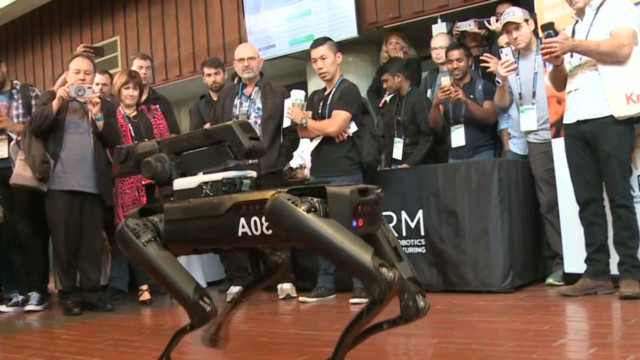The field of robotics is gaining more attention than ever before, especially when combined with artificial intelligence.
At the recent “TechCrunch Sessions: Robotics” event, technologists showcased the latest advancements.
CGTN’s Mark Niu reports.
At the University of California, Berkeley, TechCrunch Sessions: Robotics 2018 gave us a glimpse of the future. Boston Dynamics’s showed how its dog-like robot called SpotMini, can map the world and climb objects like stairs. You might have the chance to own it soon. While there’s no price yet, the company plans to start selling it commercially next year.
At the event, University of California Los Angeles researchers unveiled early prototypes of robots that are taking on the problem of walking.That’s something robots have a very difficult time mastering. The robot, NABi, solves the problem by walking sideways, or you might say backwards and forwards. Their new robot ALPHRED has four limbs, which can also be used to manipulate objects.
“The true science fiction, the Jetson’s, C-3PO’s from Star Wars robots, 20 years, 30 years, maybe more,” said Dennis Hong, a UCLA Professor and the head of its Robotics & Mechanisms Laboratory. “It might sound a little weird for a roboticist to say, but I think the general public’s expectations are just way too high.”
University of California-Berkeley researchers have developed a gripping robot that picks objects at half the speed of a human. But the researchers say its gotten twice as fast in the past year and believe it can exceed humans in a couple more.
Such advancements have led to concern over the impact of robotics on human jobs.A number of tech leaders like Telsa CEO Elon Musk have called for a universal basic income because of all the jobs he believes automation will likely wipe out.
I asked Ken Goldberg, a University of California-Berkeley Industrial Engineering Professor, whether he thought it was inevitable that robots would replace human jobs.
“No, I don’t think so,” said Goldberg. “In fact, I think we’re actually going to have a shortage of human workers in the future because of the demographics. Many workers are leaving the workforce because they are aging. And we don’t have enough workers coming in. It’s able to do some things better than humans, but there are many things where humans are going to be necessary.”
Jeff Burnstein, the president of the Association for Advancing Automation, cites the history of technological progress to justify his belief that the labor force shouldn’t fear robotics.
“We’ve looked at this over a 20-year period,” said Burnstein. “Every time in the U.S. when robot sales go up, unemployment goes down, and when robot sales go down, unemployment goes up. I think that doesn’t sound like a job killer to me. And it’s because the real threat to employment is when companies can no longer compete.”
Some robotic devices unveiled here will improve the quality of human life. SuitX showed its new robotic exoskeleton that aims to cut the price of technology that can help the paralyzed walk.
 CGTN America
CGTN America
